
Mathematical ImageryMathematical artists create strong, stunning works in all media and explore the visualization of mathematics
Mathematical Concepts Illustrated by Hamid Naderi Yeganeh
One of my goals is to create very beautiful images by using mathematical concepts such as trigonometric functions, exponential function, regular polygons, line segments, etc. I create images by running my program on a Linux operating system
— Hamid Naderi Yeganeh
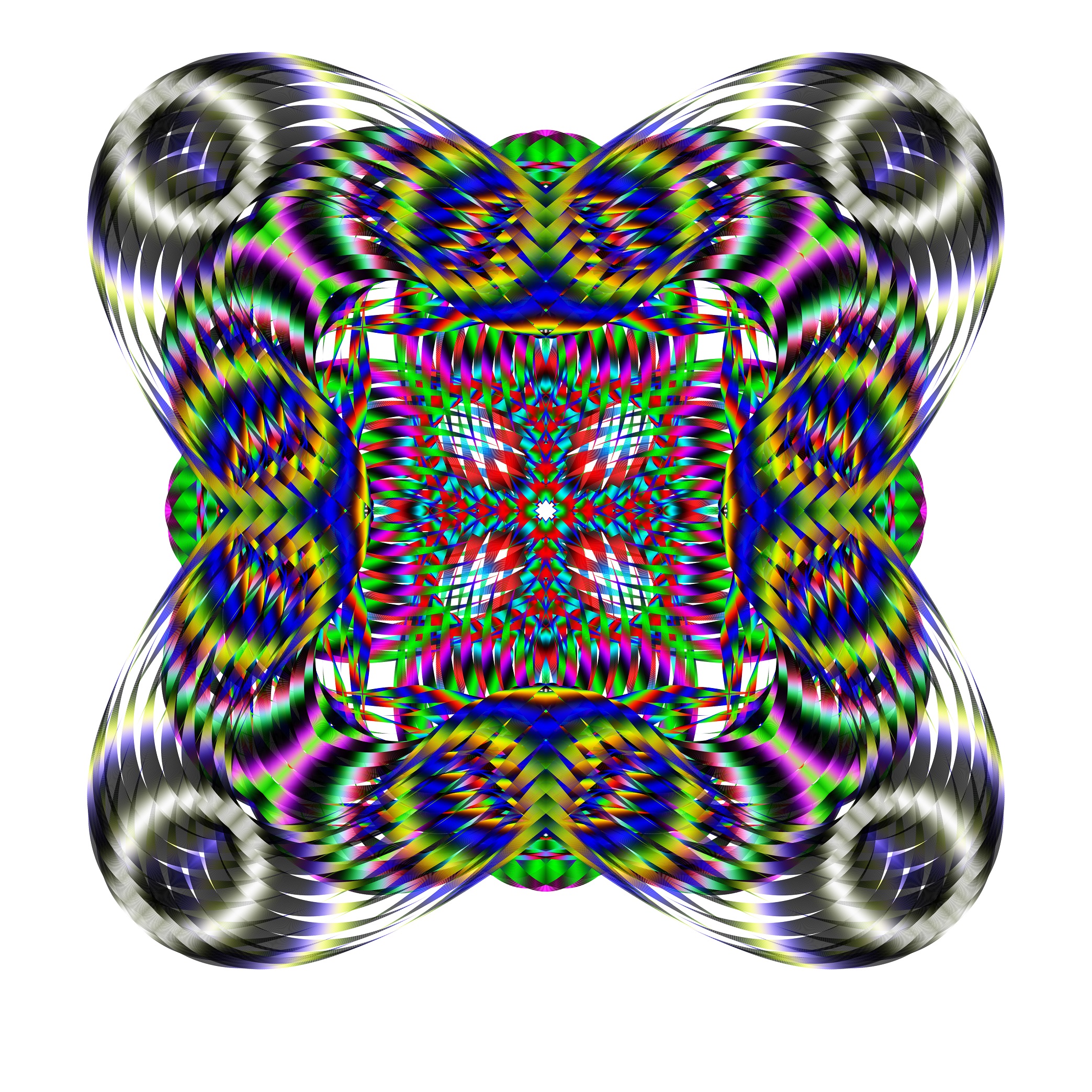
1,000,000 Line Segments (1)
This image shows $1000000$ line segments. For $k=1,2,3,...,1000000$, the endpoints of the $k$-th line segment are $(A(k), B(k))$ and $(C(k), D(k))$, where $A(k)=\cos\left(\frac{10\pi k}{1000000}\right)E(k)+\frac{1}{5}\cos\left(\frac{1700008\pi k}{1000000}\right)-\frac{1}{30}\cos\left(\frac{34\pi k}{1000000}\right)\cos\left(\frac{48\pi k}{1000000}\right)^{2},$ $B(k)=\sin\left(\frac{10\pi k}{1000000}\right)E(k)+\frac{1}{5}\sin\left(\frac{1700008\pi k}{1000000}\right)-\frac{1}{30}\sin\left(\frac{34\pi k}{1000000}\right)\cos\left(\frac{48\pi k}{1000000}\right)^{2},$ $C(k)=\cos\left(\frac{10\pi k}{1000000}\right)E(k)+\frac{1}{5}\cos\left(\frac{1700008\pi k}{1000000}\right)+\frac{1}{30}\cos\left(\frac{34\pi k}{1000000}\right)\cos\left(\frac{48\pi k}{1000000}\right)^{2},$ $D(k)=\sin\left(\frac{10\pi k}{1000000}\right)E(k)+\frac{1}{5}\sin\left(\frac{1700008\pi k}{1000000}\right)+\frac{1}{30}\sin\left(\frac{34\pi k}{1000000}\right)\cos\left(\frac{48\pi k}{1000000}\right)^{2},$ $E(k)=\frac{7}{10}+\frac{4}{10}\cos\left(\frac{24\pi k}{1000000}\right)^{2}+\frac{4}{10}\cos\left(\frac{16\pi k}{1000000}\right)^{2}-\frac{6}{10}\cos\left(\frac{4\pi k}{1000000}\right)^{2}.$
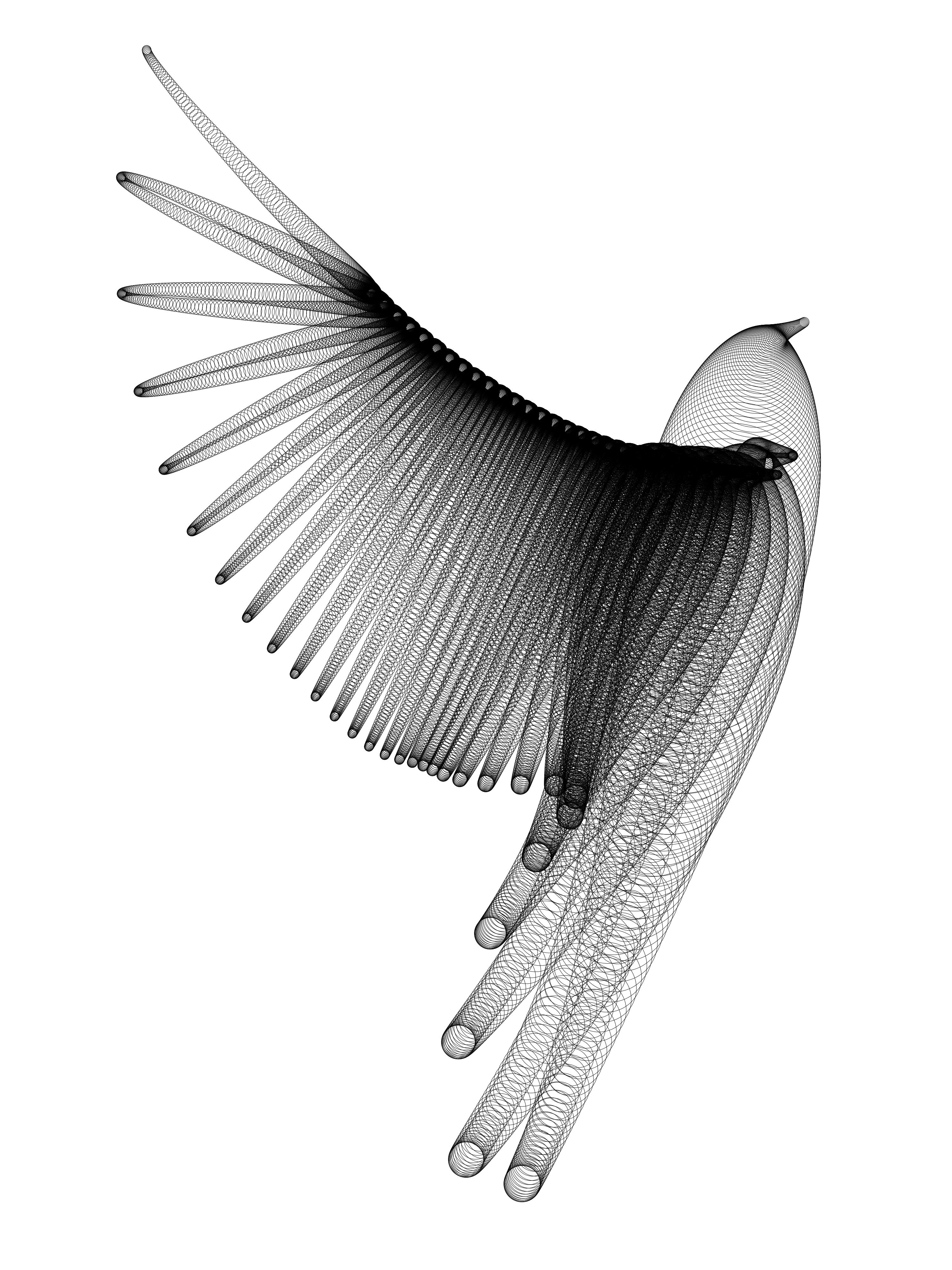
Bird
This image shows 9,830 circles. For $k=1,2,3,...,9830$, the center of the $k$-th circle is $(X(k), Y(k))$ and the radius of the $k$-th circle is $R(k)$, where $X(k)=\left(\sin\left(\frac{\pi k}{20000}\right)\right)^{12}\left(\frac{1}{2}\left(\cos\left(\frac{31\pi k}{10000}\right)\right)^{16}\sin\left(\frac{6\pi k}{10000}\right)+\frac{1}{6}\left(\sin\left(\frac{31\pi k}{10000}\right)\right)^{20}\right)+\frac{3 k}{20000}+\left(\cos\left(\frac{31\pi k}{10000}\right)\right)^{6}\sin\left(\frac{\pi}{2}\left(\frac{k-10000}{10000}\right)^{7}-\frac{\pi}{5}\right),$ $Y(k)=\frac{-9}{4}\left(\cos\left(\frac{31\pi k}{10000}\right)\right)^{6}\cos\left(\frac{\pi}{2}\left(\frac{k-10000}{10000}\right)^{7}-\frac{\pi}{5}\right)\left(\frac{2}{3}+\left(\sin\left(\frac{\pi k}{20000}\right)\sin\left(\frac{3\pi k}{20000}\right)\right)^{6}\right)+\frac{3}{4}\left(\cos\left(3\pi\frac{k-10000}{100000}\right)\right)^{10}\left(\cos\left(9\pi\frac{k-10000}{100000}\right)\right)^{10}\left(\cos\left(36\pi\frac{k-10000}{100000}\right)\right)^{14}+\frac{7}{10}\left(\frac{k-10000}{10000}\right)^{2},$ $R(k)=\left(\sin\left(\frac{\pi k}{20000}\right)\right)^{10}\left(\frac{1}{4}\left(\cos\left(\frac{31\pi k}{10000}+\frac{25\pi}{32}\right)\right)^{20}+\frac{1}{20}\left(\cos\left(\frac{31\pi k}{10000}\right)\right)^{2}\right)+\frac{1}{30}\left(\frac{3}{2}-\left(\cos\left(\frac{62\pi k}{10000}\right)\right)^{2}\right).$

Heart Curve
This image shows the following curve: $X(t)=\frac{4}{9}\sin(2t)+\frac{1}{3}\left(\sin(t)\right)^{8}\cos(3t)+\frac{1}{8}\sin(2t)\left(\cos(247t)\right)^{4},$ $Y(t)=\sin(t)+\frac{1}{3}\left(\sin(t)\right)^{8}\sin(3t)+\frac{1}{8}\sin(2t)\left(\sin(247t)\right)^{4},$ $0\leq t \leq \pi.$

Africa
This image shows a self-similar pattern which is constructed by an Africa-like octagon and its lateral inversion. In this fractal, the numbers of octagons and the number of isosceles triangles of each size are related to the Fibonacci sequence. And the height of the biggest octagon is $\varphi$ time larger than the height of the second octagon, where $\varphi$ is the golden ratio. The vertices of the largest octagon of the fractal are: $A=(a_1,a_2)=\left(0,0\right), $ $B=(b_1,b_2)=\left(2,0\right), $ $C=(c_1,c_2)=\left(3,\frac{16}{3}\right),$ $D=(d_1,d_2)=\left(4-\sqrt{5}, \frac{16}{3}\right), $ $E=(e_1,e_2)=\left(\frac{9-3\sqrt{5}}{2},\frac{8\sqrt{5}+8}{3}\right),$ $F=(f_1,f_2)=\left(\frac{-3+\sqrt{5}}{2}-\frac{\sqrt{5}-3}{2-\sqrt{5}},\frac{8\sqrt{5}+8}{3}\right), $ $G=(g_1,g_2)=\left(-1-\frac{\sqrt{5}-3}{2-\sqrt{5}},\frac{16}{3}\right),$ $H=(h_1,h_2)=\left(-1,\frac{16}{3}\right).$ The following equations are necessary for the octagon to form the fractal: $c_1-b_1=a_1-h_1,$ $d_1-e_1=f_1-g_1,$ $c_2-b_2=h_2-a_2,$ $e_2-d_2=f_2-g_2,$ $\frac{b_1-a_1}{c_1-d_1}=\frac{c_1-b_1}{d_1-e_1}=\frac{c_2-b_2}{e_2-d_2}= \frac{1+\sqrt5}{2}=\varphi,$ $\frac{2(h_1-g_1)}{\varphi}+\frac{b_1-a_1}{\varphi^2}=e_1-f_1.$ .
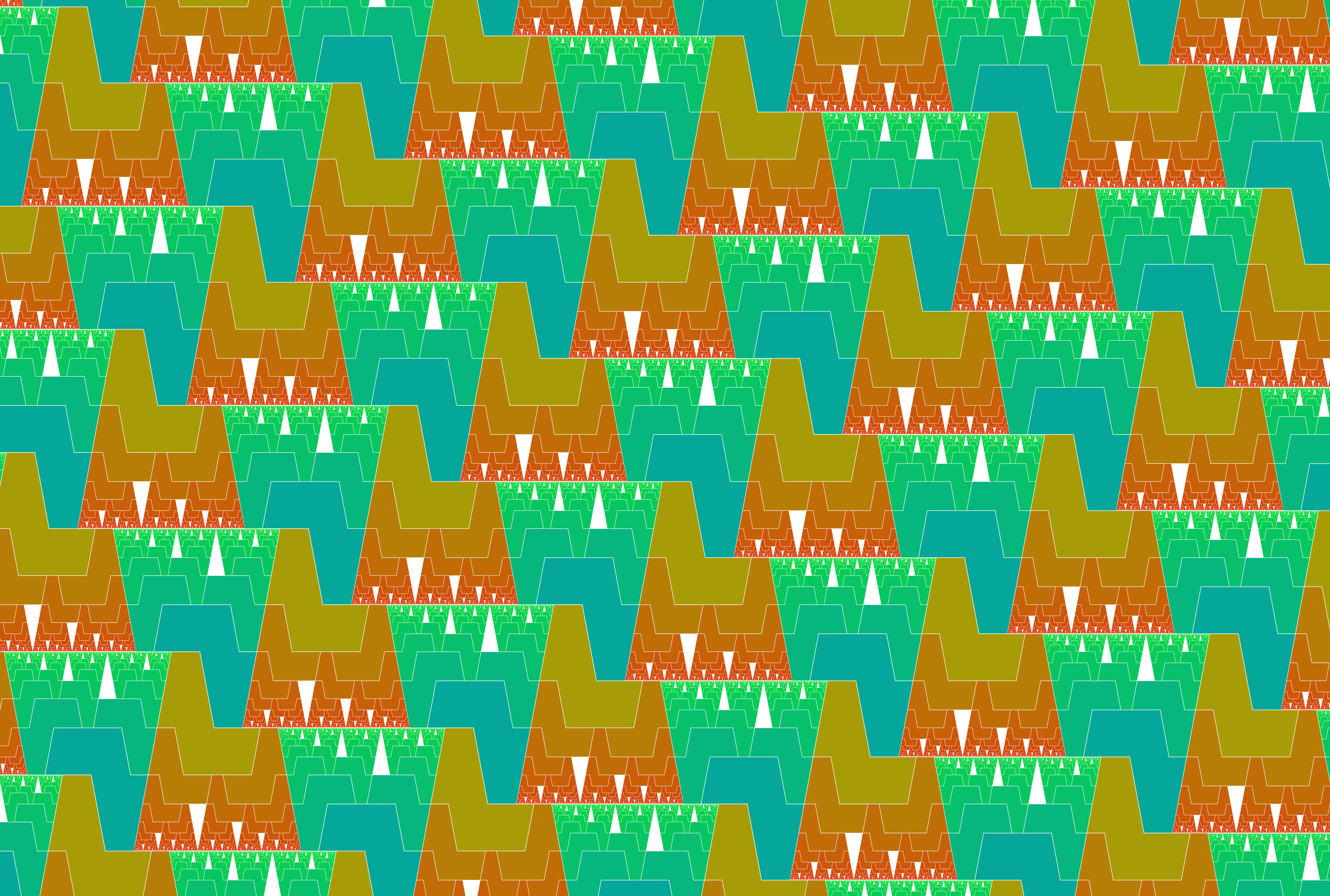
The shape of Fractal Africa can form this tessellation.

The shape of Fractal Africa can form this tessellation.
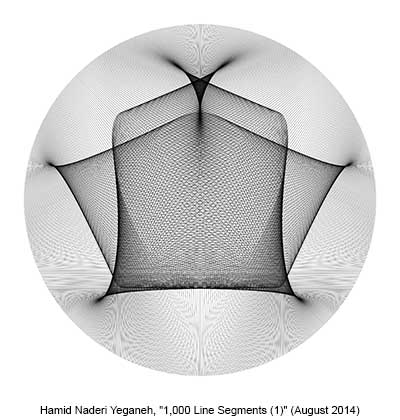
This image shows 1,000 line segments. For each $i=1,2,3,\ldots\ldots,1000$ the endpoints of the $i$-th line segment are: $(-\sin(2\pi i/1000), -\cos(2\pi i/1000))$ and $((-1/2)\sin(8\pi i/1000), (-1/2)\cos(12\pi i/1000))$. I created this image by running my program on a Linux operating system.
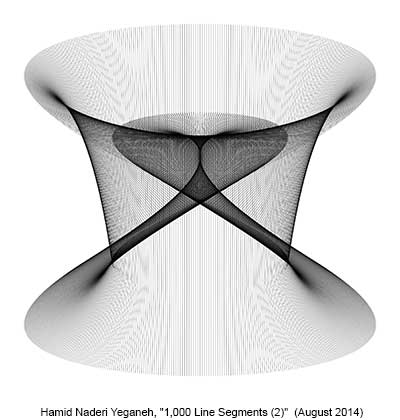
This image shows 1,000 line segments. For each $i=1,2,3,\ldots,1000$ the endpoints of the $i$-th line segment are: $(-\sin(4\pi i/1000), -\cos(2\pi i/1000))$ and $((-1/2)\sin(8\pi i/1000), (-1/2)\cos(4\pi i/1000))$. I created this image by running my program on a Linux operating system.
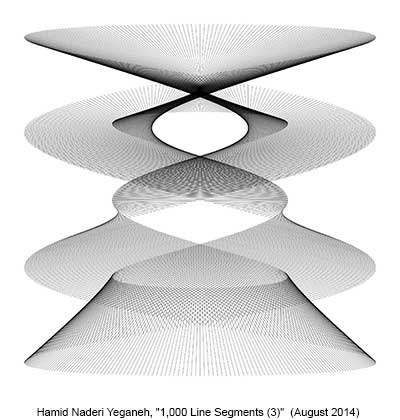
This image shows 1,000 line segments. For each $i=1,2,3,\ldots,1000$ the endpoints of the line segment are: $(-\sin(8\pi i/1000), -\cos(2\pi i/1000))$ and $((-1/2)\sin(6\pi i/1000), (-1/2)\cos(2\pi i/1000))$. I created this image by running my program on a Linux operating system.
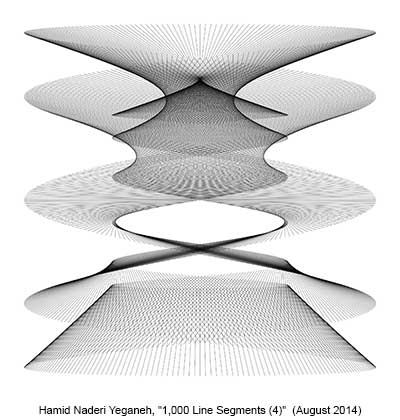
This image shows 1,000 line segments. For each $i=1,2,3,\ldots,1000$ the endpoints of the $i$-th line segment are: $(-\sin(10\pi i/1000), -\cos(2\pi i/1000))$ and $((-1/2)\sin(12\pi i/1000), (-1/2)\cos(2\pi i/1000))$. I created this image by running my program on a Linux operating system.
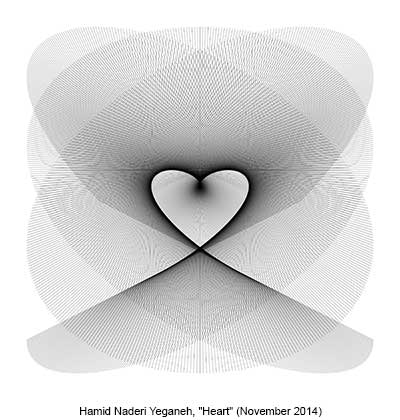
This image contains a heart-like figure. It shows 601 line segments. For each $i=1, 2, 3, \ldots. , 601$ the endpoints of the $i$-th line segment are:
$(\sin(10\pi (i+699)/2000), \cos(8\pi (i+699)/2000))$
and
$(\sin(12\pi (i+699)/2000), \cos(10\pi (i+699)/2000))$.
I created this image by running my program.
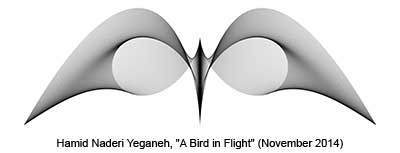
This image is like a bird in flight. It shows 2000 line segments. For each $i=1, 2, 3, \ldots , 2000$ the endpoints of the $i$-th line segment are:
$(3(\sin(2\pi i/2000)^3), -\cos(8\pi i/2000))$
and
$((3/2)(\sin(2\pi i/2000)^3), (-1/2)\cos(6\pi i/2000))$.
I created this image by running my program.
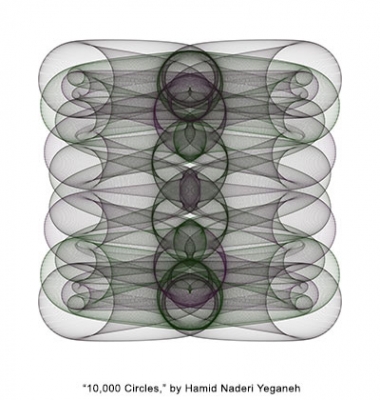
This image shows 10,000 circles. For each $i=1,2,3,\ldots,10{,}000$ the center of the $i$-th circle is:
$((\cos(38\pi i/10{,}000))^3, \sin(10\pi i/10{,}000))$ and the radius of the $i$-th circle is: $(1/3)(\sin(16\pi i/10{,}000))^2$.
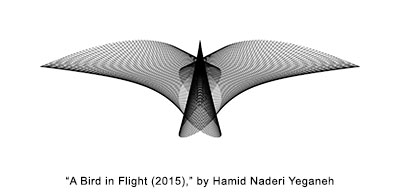
This image is like a bird in flight. It shows 500 line segments. For each $i=1,2,3,\ldots,500$ the endpoints of the $i$-th line segment are: $((3/2)(\sin((2\pi i/500)+(\pi /3)))^7, (1/4)(\cos(6\pi i/500))^2)$ and
$((1/5)\sin((6\pi i/500)+(\pi /5)), (-2/3)(\sin((2\pi i/500)-(\pi /3)))^2).$
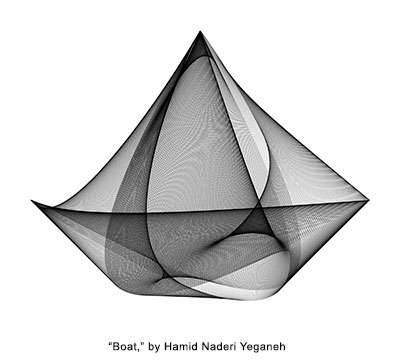
This image is like a sailing boat. It shows 2,000 line segments. For each $k=1,2,3,\ldots,2000$ the endpoints of the $k$-th line segment are: $(\cos(6\pi k/2000)-i \cos(12\pi k/2000))e^{3\pi i/4}$ and $(\sin((4\pi k/2000)+(\pi /8))+i \sin((2\pi k/2000)+(\pi /3)))e^{3\pi i/4}.$
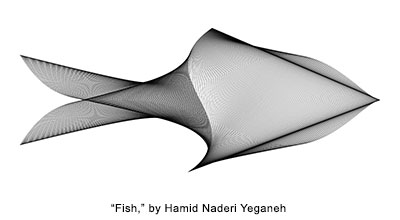
This image is like a fish. It shows 1,000 line segments. For $i=1,2,3,\ldots,1000$ the endpoints of the $i$-th line segment are: $(-2\cos(4\pi i/1000), (1/2)(\cos(6\pi i/1000))^3)$ and $(-(2/15)\sin(6\pi i/1000), (4/5)\sin(2\pi i/1000))$.
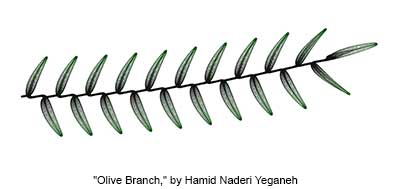
This image shows 4000 circles. For $k=1,2,3,\ldots,4000$ the center of the $k$-th circle is $(X(k), Y(k))$ and the radius of the $k$-th circle is $R(k)$, where
$\begin{array}{llll}X(k)&=&&(2k/4000)+(1/28)\sin(42\pi k/4000)\\&&+ &(1/9)((\sin(21\pi k/4000))^8)\\&&+ &(1/4)((\sin(21\pi k/4000))^6)*\\ && &\sin((2\pi /5)(k/4000)^{12}),\end{array}$
$\begin{array}{llll}Y(k)&=&&(1/4)(k/4000)^2\\&&+&(1/4)(((\sin(21\pi k/4000))^5) \\&& + &(1/28)\sin(42\pi k/4000))*\\&&&(\cos((\pi /2)(k/4000)^{12})),\end{array}$
$\begin{array}{lll}R(k)& =& (1/170)+(1/67)((\sin(42\pi k/4000))^2)*\\& &(1-((\cos(21\pi k/4000))^4)).\end{array}$
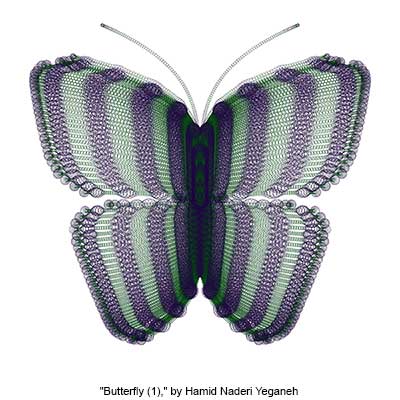
This image shows 40,000 circles. For $k=1,2,3,\ldots,40{,}000$ the center of the $k$-th circle is $(X(k), Y(k))$ and the radius of the $k$-th circle is $R(k)$, where
$\begin{array}{lll}X(k)&=&(6/5)((\cos(141\pi k/40{,}000))^9)(1-(1/2)(\sin(\pi k/40{,}000))^3)*\\&&(1-(1/4)((\cos(2\pi k/40{,}000))^{30})(1+(2/3)(\cos(30\pi k/40{,}000))^{20})-\\&&((\sin(2\pi k/40{,}000))^{10})((\sin(6\pi k/40{,}000))^{10})*\\&&((1/5)+(4/5)(\cos(24\pi k/40{,}000))^{20})),\end{array}$
$\begin{array}{lll}Y(k)&=&\cos(2\pi k/40{,}000)((\cos(141\pi k/40{,}000))^2)(1+(1/4)((\cos(\pi k/40{,}000))^{24})*\\&&((\cos(3\pi k/40{,}000))^{24})(\cos(19\pi k/40{,}000))^{24}),\end{array}$
$\begin{array}{lll}R(k)&=&(1/100)+(1/40)(((\cos(2820\pi k/40{,}000))^6)+\\&&(\sin(141\pi k/40{,}000))^2)(1-((\cos(\pi k/40{,}000))^{16})*\\&&((\cos(3\pi k/40{,}000))^{16})(\cos(12\pi k/40{,}000))^{16}).\end{array}$
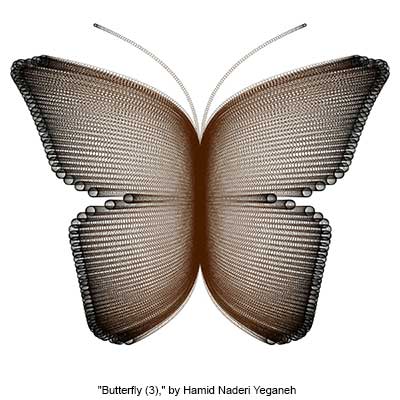
This image shows 40,000 circles. For $k=1,2,3,\ldots,40{,}000$ the center of the $k$-th circle is $(X(k), Y(k))$ and the radius of the $k$-th circle is $R(k)$, where
$\begin{array}{lll}X(k)&=&(3/2)((\cos(141\pi k/40{,}000))^9)*\\&&(1-(1/2)\sin(\pi k/40{,}000))*\\&&(1-(1/4)((\cos(2\pi k/40{,}000))^{30})*\\&&(1+(\cos(32\pi k/40{,}000))^{20}))*\\&&(1-(1/2)((\sin(2\pi k/40{,}000))^{30})*\\&&((\sin(6\pi k/40{,}000))^{10})*\\&&((1/2)+(1/2)(\sin(18\pi k/40{,}000))^{20})),\end{array}$
$\begin{array}{lll}Y(k)&=&\cos(2\pi k/40{,}000)*\\&&((\cos(141\pi k/40{,}000))^2)*\\&&(1+(1/4)((\cos(\pi k/40{,}000))^{24})*\\&&((\cos(3\pi k/40{,}000))^{24})*\\&&(\cos(21\pi k/40{,}000))^{24}),\end{array}$
$\begin{array}{lllcl}R(k)&=&(1/100)&+&(1/40)(((\cos(141\pi k/40{,}000))^{14})+(\sin(141\pi k/40{,}000))^6)*\\&&&&(1-((\cos(\pi k/40{,}000))^{16})((\cos(3\pi k/40{,}000))^{16})*\\&&&&(\cos(12\pi k/40{,}000))^{16}).\end{array}$
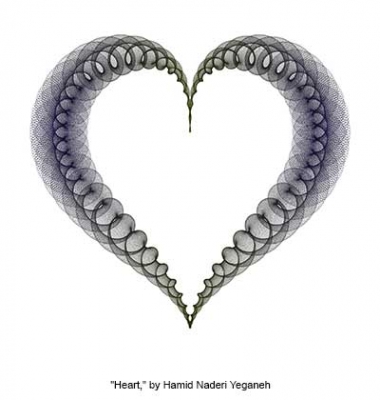
This image shows 2500 ellipses. For each $k=1,2,3,\ldots,2500$ the foci of the $k$-th ellipse are:
$A(k)+iB(k)+C(k)e^{68\pi i k/2500}$
and
$A(k)+iB(k)-C(k)e^{68\pi i k/2500}$
and the eccentricity of the $k$-th ellipse is $D(k)$, where
$A(k)=(-3/2)((\sin(2\pi k/2500))^3)+(3/10)((\sin(2\pi k/2500))^7),$
$B(k)=\sin((2\pi k/1875)+(\pi /6))+(1/4)(\sin((2\pi k/1875)+(\pi /6)))^3,$
$C(k)=(2/15)-(1/8)\cos(\pi k/625),$
$D(k)=(49/50)-(1/7)(\sin(4\pi k/2500))^4.$
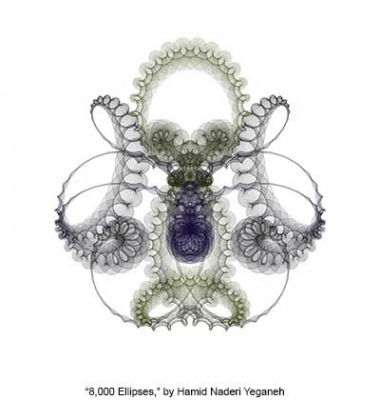
This image shows 8,000 ellipses. For each $k=1,2,3,\ldots,8000$ the foci of the $k$-th ellipse are:
$A(k)+iB(k)+C(k)e^{300\pi ik/8000}$
and
$A(k)+iB(k)-C(k)e^{300\pi ik/8000}$
and the eccentricity of the $k$-th ellipse is $D(k)$, where
$\begin{array}{llll}A(k)&=&&(3/4)\sin(2\pi k/8000)\cos(6\pi k/8000)\\&&+&(1/4)\sin(28\pi k/8000),\end{array}$
$\begin{array}{llll}B(k)&=&&(3/4)\cos(2\pi k/8000)\cos(8\pi k/8000)\\&&+&(1/4)\cos(28\pi k/8000),\end{array}$
$\begin{array}{lll}C(k)&=&(1/18)+(1/20)\cos(24\pi k/8000),\end{array}$
$ \begin{array}{lll} D(k)&=&(49/50)-(1/7)(\sin(10\pi k/8000))^4.\end{array}$
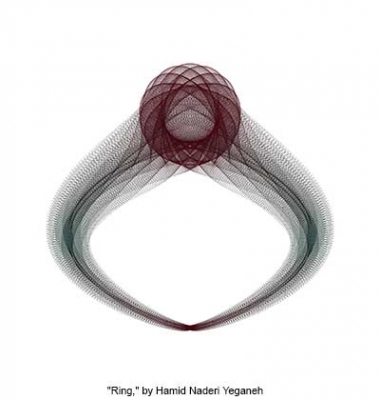
This image shows 5600 ellipses. For each $k=1,2,3,\ldots,5600$ the foci of the $k$-th ellipse are:
$A(k)+iB(k)+C(k)e^{44\pi ik/5600}$
and
$A(k)+iB(k)-C(k)e^{44\pi ik/5600}$
and the eccentricity of the $k$-th ellipse is $D(k)$, where
$\begin{array}{lll}A(k)&=&(\cos(28\pi k/5600))^3,\end{array}$
$\begin{array}{llll}B(k)&=&&\sin(28\pi k/5600)\\&&+&(1/4)(\cos((14\pi k/5600)-(7\pi /4)))^{18},\end{array}$
$\begin{array}{lll}C(k)&=&(1/70)+(1/6)+(1/6)\sin(28\pi k/5600),\end{array}$
$\begin{array}{lll}D(k)&=&(399/400)-(1/6)(\sin(28\pi k/5600))^8.\end{array}$
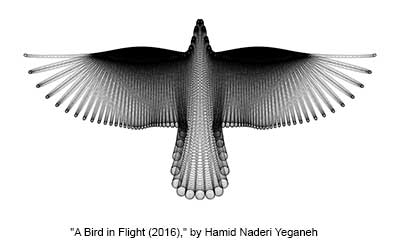
This image shows all circles of the form:
$(x-A(k))^2+(y-B(k))^2=(R(k))^2$, for $k=-10000, -9999, \ldots , 9999, 10000$, where
$\begin{array}{lllcl}A(k)&=&(3k/20{,}000)&+&\sin((\pi /2)(k/10{,}000)^7)((\cos(41\pi k/10{,}000))^6)\\&&&+&(1/4)((\cos(41\pi k/10{,}000))^{16})((\cos(\pi k/20{,}000))^{12})\sin(6\pi k/10{,}000),\end{array}$
$\begin{array}{lll}B(k)&=&-\cos((\pi /2)(k/10{,}000)^7)*\\&&(1+(3/2)(\cos(\pi k/20{,}000)\cos(3\pi k/20{,}000))^6)*\\&&((\cos(41\pi k/10{,}000))^6)+(1/2)(\cos(3\pi k/100{,}000)\cos(9\pi k/100{,}000)\cos(18\pi k/100{,}000))^{10},\end{array}$
$\begin{array}{lllcl}R(k)&=&(1/50)&+&(1/10)((\sin(41\pi k/10{,}000)\sin(9\pi k/100{,}000))^2)\\&&&+&(1/20)((\cos(41\pi k/10{,}000))^2)((\cos(\pi k/20{,}000))^{10}).\end{array}$



